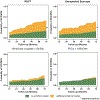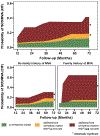Role of arrhythmic phenotype in prognostic stratification and management of dilated cardiomyopathy
- PMID: 38404225
- PMCID: PMC12009134
- DOI: 10.1002/ejhf.3168
Role of arrhythmic phenotype in prognostic stratification and management of dilated cardiomyopathy
Abstract
Aims: Dilated cardiomyopathy (DCM) with arrhythmic phenotype combines phenotypical aspects of DCM and predisposition to ventricular arrhythmias, typical of arrhythmogenic cardiomyopathy. The definition of DCM with arrhythmic phenotype is not universally accepted, leading to uncertainty in the identification of high-risk patients. This study aimed to assess the prognostic impact of arrhythmic phenotype in risk stratification and the correlation of arrhythmic markers with high-risk arrhythmogenic gene variants in DCM patients.
Methods and results: In this multicentre study, DCM patients with available genetic testing were analysed. The following arrhythmic markers, present at baseline or within 1 year of enrolment, were tested: unexplained syncope, rapid non-sustained ventricular tachycardia (NSVT), ≥1000 premature ventricular contractions/24 h or ≥50 ventricular couplets/24 h. LMNA, FLNC, RBM20, and desmosomal pathogenic or likely pathogenic gene variants were considered high-risk arrhythmogenic genes. The study endpoint was a composite of sudden cardiac death and major ventricular arrhythmias (SCD/MVA). We studied 742 DCM patients (45 ± 14 years, 34% female, 410 [55%] with left ventricular ejection fraction [LVEF] <35%). During a median follow-up of 6 years (interquartile range 1.6-12.1), unexplained syncope and NSVT were the only arrhythmic markers associated with SCD/MVA, and the combination of the two markers carried a significant additive risk of SCD/MVA, incremental to LVEF and New York Heart Association class. The probability of identifying an arrhythmogenic genotype rose from 8% to 30% if both early syncope and NSVT were present.
Conclusion: In DCM patients, the combination of early detected NSVT and unexplained syncope increases the risk of life-threatening arrhythmic outcomes and can aid the identification of carriers of malignant arrhythmogenic genotypes.
Keywords: Arrhythmogenic cardiomyopathy; Arrhythmogenic genotype; Dilated cardiomyopathy; Dilated cardiomyopathy with arrhythmic phenotype; Non‐sustained ventricular tachycardia; Unexplained syncope.
© 2024 European Society of Cardiology.
Conflict of interest statement
Figures




Similar articles
-
Late gadolinium enhancement dispersion for predicting malignant arrhythmic events in patient with non-ischaemic dilated cardiomyopathy.Eur Heart J Cardiovasc Imaging. 2025 Jun 30;26(7):1217-1232. doi: 10.1093/ehjci/jeaf124. Eur Heart J Cardiovasc Imaging. 2025. PMID: 40244913
-
Arrhythmic risk stratification in patients with dilated cardiomyopathy and intermediate left ventricular dysfunction.J Cardiovasc Med (Hagerstown). 2019 May;20(5):343-350. doi: 10.2459/JCM.0000000000000792. J Cardiovasc Med (Hagerstown). 2019. PMID: 30921270
-
Late Gadolinium Enhancement and the Risk for Ventricular Arrhythmias or Sudden Death in Dilated Cardiomyopathy: Systematic Review and Meta-Analysis.JACC Heart Fail. 2017 Jan;5(1):28-38. doi: 10.1016/j.jchf.2016.09.017. Epub 2016 Dec 21. JACC Heart Fail. 2017. PMID: 28017348
-
Magnetic Resonance Imaging Characterization and Clinical Outcomes of Dilated and Arrhythmogenic Left Ventricular Cardiomyopathies.J Am Coll Cardiol. 2024 May 14;83(19):1841-1851. doi: 10.1016/j.jacc.2024.02.041. J Am Coll Cardiol. 2024. PMID: 38719365 Free PMC article.
-
Noninvasive electrocardiographic risk factors for sudden cardiac death in dilated ca rdiomyopathy: is ambulatory electrocardiography still relevant?Heart Fail Rev. 2023 Jul;28(4):865-878. doi: 10.1007/s10741-023-10300-x. Epub 2023 Mar 6. Heart Fail Rev. 2023. PMID: 36872393 Free PMC article.
Cited by
-
Arrhythmic Risk Stratification of Carriers of Filamin C Truncating Variants.JAMA Cardiol. 2025 Apr 1;10(4):359-369. doi: 10.1001/jamacardio.2024.5543. JAMA Cardiol. 2025. PMID: 39937464
-
Fenotypic expressions and clinical manifestations of arrhythmogenic cardiomyopathy.Eur Heart J Suppl. 2025 Apr 16;27(Suppl 3):iii143-iii149. doi: 10.1093/eurheartjsupp/suaf033. eCollection 2025 Mar. Eur Heart J Suppl. 2025. PMID: 40248311 Free PMC article.
-
Prime Editing Corrects Multiple Mutations in the RSRSP Region of the RBM20 Gene Using a Single Prime Editing Guide RNA.JMA J. 2025 Apr 28;8(2):587-590. doi: 10.31662/jmaj.2025-0004. Epub 2025 Mar 21. JMA J. 2025. PMID: 40416037 Free PMC article. No abstract available.
-
Troponin T Assessment Allows for Identification of Mutation Carriers among Young Relatives of Patients with LMNA-Related Dilated Cardiomyopathy.J Clin Med. 2024 May 28;13(11):3164. doi: 10.3390/jcm13113164. J Clin Med. 2024. PMID: 38892874 Free PMC article.
-
Genotype-phenotype insights of pediatric dilated cardiomyopathy.Front Pediatr. 2025 Jan 31;13:1505830. doi: 10.3389/fped.2025.1505830. eCollection 2025. Front Pediatr. 2025. PMID: 39959410 Free PMC article. Review.
References
-
- Maron BJ, Towbin JA, Thiene G, Antzelevitch C, Corrado D, Arnett D, et al. Contemporary definitions and classification of the cardiomyopathies: An American Heart Association scientific statement from the Council on Clinical Cardiology, Heart Failure and Transplantation Committee; Quality of Care and Outcomes Research and Functional Genomics and Translational Biology Interdisciplinary Working Groups; and Council on Epidemiology and Prevention. Circulation 2006;113:1807–1816. 10.1161/CIRCULATIONAHA.106.174287 - DOI - PubMed
Publication types
MeSH terms
Grants and funding
LinkOut - more resources
Full Text Sources
Miscellaneous

